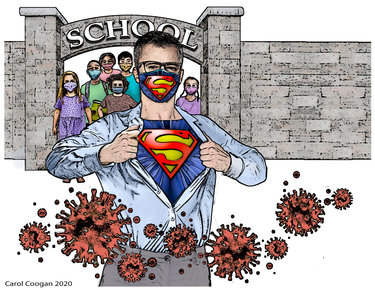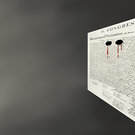What do you consider an acceptable mortality rate for schoolchildren? We came up with the same number.
What do you consider an acceptable mortality rate for schoolchildren? We came up with the same number.
We continue to be amazed and inspired by the way our local school districts — Berne-Knox-Westerlo, Guilderland, and Voorheesville — have handled the coronavirus pandemic. We commend school leaders, teachers, and staff as well as parents and the students themselves for working together to stay safe.
Each of our three districts came up with plans — recreating school out of the ether, the Guilderland superintendent called it — that would minimize the risk of students who chose to return to in-person learning while providing remote-learning options for those who felt safer staying home.
We know in-person learning is particularly important for children with disabilities, for children in low-income households, and for children learning English as a new language.
We also know that schools are important for households where both parents work or households headed by single parents.
The schools we cover, both rural and suburban, have not yet experienced the draconian cuts in aid that neighboring city districts have suffered.
Learning continues apace. The students in our schools continue to grow as faculty and staff find creative ways to let them experience some sense of normalcy while staying safe.
We noted, for example, at a BKW cross-country meet last week that the athletes ran only two at a time so as not to bunch together as so often happens in a race.
We were thrilled, too, to talk to English teacher Andy Maycock who usually produces the Guilderland High School fall plan about his plan to have a series of monologues instead. So not only will those students experience the value of theater but other students will be included as well, to write the monologues.
In this way, the copyright issues that wouldn’t allow the canceled spring productions to be filmed can be avoided and the show will go on.
We’ve heard from many parents who are pleased with the results of the current learning in their schools. And we commend them as well. Parents play an important part in checking to make sure their children don’t have symptoms of COVID-19 and also in making sure they don’t participate in some of the normal childhood behaviors that are now risky.
So far, there have been only five cases of COVID-19 in our schools this semester — two at Altamont Elementary, two at Guilderland High School, and one at Voorheesville Middle School.
There will be more. Albany County’s COVID-19 dashboard shows an uptick in cases for 10- to 19-year-olds; as of Saturday, that number stood at 373. For children up to age 9, the county’s tally is 84.
But, if future cases are handled as well as these first five, we feel confident that schooling can continue. The principal at Altamont Elementary, Peter Brabant, just two school days after the two cases were confirmed a this school, used words like “beautiful” and “heart-warming” to describe the way the school community had come together to allow both the students in class and the students quarantined at home to continue learning.
Big screens were set up in classrooms so that teachers, quarantined at home, could still present lessons to kids at the school. Because the students learn in cohorts, staying together all day and rarely intersecting with other students, just a first-grade class and a third-grade class had to be quarantined. Brabant described the classroom cohorts as self-contained bubbles.
Our concerns are not at the local level, where we believe our students are in good hands. Our concerns lie at the state level — Governor Andrew Cuomo has said aid to schools will be cut if federal funding does not come through — and more importantly, at the federal level.
Our future, as a society, depends on our children, each of them, getting a good education. The federal government should have its next stimulus package make state and local governments whole for the costs they’ve borne in combatting the pandemic.
The pandemic has shown us how poor communities and Black communities have suffered more than white and wealthy communities. Cutting school aid will widen the gap.
We’re gratified that, in the midst of this crisis, Guilderland is forging ahead with naming a committee to focus on equity and diversity in the school community. Carpe crisis.
Most alarming, though, is the political meddling with health advice from the Centers for Disease Control and Prevention.
Over the last few months, as we’ve talked to school leaders, we’ve learned how much they depend on recommendations from the CDC. They are not scientists or health experts — nor should they be. In drawing up their school plans, they naturally rely on the CDC to distill the latest ongoing research on the coronavirus into useful recommendations to keep students safe.
Donald Trump has claimed that children aren’t much affected by COVID-19, which simply is not true. We understand that schools are essential for parents to return to work and the focus has been on regaining economic stability. But the truth — as far as science has been able to determine it — should not be twisted.
We wrote on this page in September — “Science, not politics, should guide our government” — how deeply troubled we were when the CDC changed its guidelines to exclude testing people who do not show COVID-19 symptoms even if they have been exposed to the virus.
In Albany County, and across New York State, the focus for months has been on increasing diagnostic testing, especially to identify COVID-19 in people who may be spreading the disease before they show symptoms or who never show symptoms. Eventually, the CDC switched back to recommending testing.
In September, The New York Times reported that top White House officials had pressured the CDC to play down the risk of sending children back to school, even searching for alternate data to show that the pandemic was weakening and posed little danger to children.
President Trump tweeted in July, “I disagree with @CDCgov on their very tough & expensive guidelines for opening schools. While they want them open, they are asking schools to do very impractical things. I will be meeting with them!!!”
The White House-influenced document, which the CDC ultimately published, “The Importance of Reopening America’s Schools this Fall,” includes information to which CDC officials had objectd, The Times reports, suggesting COVID-19 is less deadly to children than the seasonal flu.
This month, in the last presidential debate, Trump again called for schools to open as normal. This week, our nation reached an all-time high for the daily rate of COVID-19 infection.
Sacrificing the safety of children for political expediency is unacceptable. Schools need both accurate guidance and adequate funding to keep our children safe.


